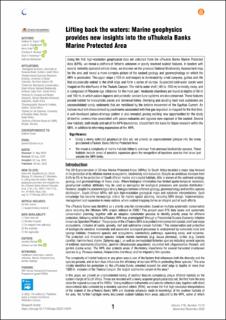| dc.contributor.author | Green, Andrew N. | |
| dc.contributor.author | Engelbrecht, Luke D. | |
| dc.contributor.author | Sink, Kerry | |
| dc.contributor.author | Mackay, Christine F. | |
| dc.contributor.author | Fennessy, Sean T. | |
| dc.contributor.author | Michalsen, Kathrine | |
| dc.date.accessioned | 2023-03-06T12:41:22Z | |
| dc.date.available | 2023-03-06T12:41:22Z | |
| dc.date.created | 2023-03-01T09:35:17Z | |
| dc.date.issued | 2022 | |
| dc.identifier.citation | South African Journal of Science. 2022, 118 (11-12), . | en_US |
| dc.identifier.issn | 0038-2353 | |
| dc.identifier.uri | https://hdl.handle.net/11250/3056060 | |
| dc.description.abstract | Using the first high-resolution geophysical data set collected from the Thukela Banks Marine Protected Area (MPA), we reveal a plethora of hitherto unknown or poorly resolved seabed features. In tandem with several remotely operated vehicle dives, we improve on the previous National Biodiversity Assessment map for the area and reveal a more complex picture of the seabed geology and geomorphology on which the MPA is predicated. The upper slope (-120 m and deeper) is dominated by small canyons, gullies and rills that occasionally extend to the shelf edge and form a series of slumps. Suspected cold-water corals were imaged on the interfluves of the Thukela Canyon. The mid to outer shelf (-60 to -100 m) is mostly rocky, and is composed of Pliocene-age siltstones for the most part. Aeolianite shorelines are found at depths of 60 m and 100 m, in which palaeo-lagoons and parabolic aeolian dune systems are also preserved. These features provide habitat for mesophotic corals and demersal fishes. Overlying and abutting hard rock substrates are unconsolidated sandy sediments that are mobilised by the inshore movement of the Agulhas Current. An inshore mud belt characterised by pockmarks associated with free gas expulsion is mapped for the first time. A well-developed palaeo-drainage pattern is also revealed, posing exciting new opportunities for the study of benthic communities associated with palaeo-estuaries and lagoons now exposed at the seabed. Several new habitats, both inside and out of the MPA boundaries, should form the basis for future research within the MPA, in addition to informing expansions of the MPA. | en_US |
| dc.language.iso | eng | en_US |
| dc.title | Lifting back the waters: Marine geophysics provides new insights into the uThukela Banks Marine Protected Area | en_US |
| dc.title.alternative | Lifting back the waters: Marine geophysics provides new insights into the uThukela Banks Marine Protected Area | en_US |
| dc.type | Peer reviewed | en_US |
| dc.type | Journal article | en_US |
| dc.description.version | publishedVersion | en_US |
| dc.source.pagenumber | 0 | en_US |
| dc.source.volume | 118 | en_US |
| dc.source.journal | South African Journal of Science | en_US |
| dc.source.issue | 11-12 | en_US |
| dc.identifier.doi | 10.17159/sajs.2022/14020 | |
| dc.identifier.cristin | 2130371 | |
| cristin.ispublished | true | |
| cristin.fulltext | original | |
| cristin.qualitycode | 1 | |
